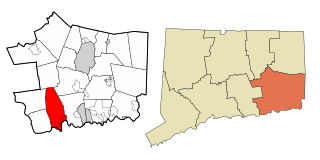
East Lyme is a town in New London County, Connecticut, United States. The population was 18,693 at the 2020 census. The villages of Niantic and Flanders are located in the town.
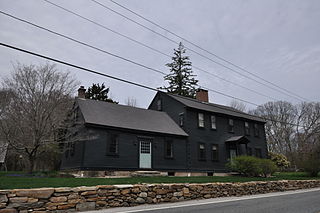
The Mount Vernon Tavern, also known as the Bank House Tavern, is an historic house in Foster, Rhode Island. It is located at 199 Plainfield Pike, about 3/10 of a mile east of its junction with Howard Hill Road. The main block of the house, a 2+1⁄2-story wood-frame structure with gable roof, was built c. 1760, and was originally attached to an even older structure which was demolished in the late 19th century. This main block, five bays wide with a central chimney, is attached to a 1+1⁄2-story gable-roofed ell to the west. The main entrance portico features unusually elaborate Federal styling for a rural location, and was probably added in 1814. The house has long been a landmark on the road, serving as a stagecoach stop on what was the main road between Providence and points in Connecticut.
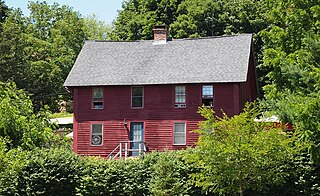
The Quaker Hill Historic District encompasses the center a mainly residential village in northeastern Waterford, Connecticut. Running in a mostly linear fashion along Old Norwich Road between Connecticut Route 32 and Richard Grove Road, the area first grew as a settlement of religious non-conformists in the 17th century, developed in the 19th century as a small industrial village, and became more suburban in character in the 20th century. Its architecture is reflective of these changes, and it was listed on the National Register of Historic Places in 2002.

The Clinton Village Historic District encompasses the historic portion of the town center of Clinton, Connecticut. It is roughly linear and extends along East Main Street from the Indian River in the west to Old Post Road in the east. The area represents a well-preserved mid-19th century town center, with architecture dating from the late 17th to mid-20th centuries. The district was listed on the National Register of Historic Places in 1994.

The Golden Ball Tavern is a historic tavern, now a museum, located in Weston, Massachusetts. Built in 1768, it is one of the town's finest examples of Late Georgian architecture. It also played a pivotal role in local activities during the American Revolution, due to its Loyalist tavern keeper. The tavern was listed on the National Register of Historic Places in 1972, and was included in Weston's Boston Post Road Historic District in 1983.
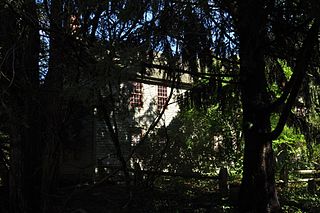
The Mixer Tavern is a historic tavern, now a private residence, at 14 Westford Road in Ashford, Connecticut. Portions of the building date to 1710, making it one of Ashford's oldest buildings. It is also distinctive for its well-preserved tavern features, and its long history as a traveler's accommodation and local meeting point. The building was listed on the National Register of Historic Places in 1994.

The Caleb Baldwin Tavern is a historic house at 32 Main Street in the Newtown Borough Historic District, located in Newtown, Connecticut, United States. Built c. 1763, the two-and-a-half-story house it is considered historically significant for its role in movement of French forces of Rochambeau, in which the building housed some of the army's officers in June 1781, en route to the Siege of Yorktown. It also an example of traditional 18th-century New England architecture, and retains some details from that time period. It was individually listed on the National Register of Historic Places on August 23, 2002.

The former Smith Tavern is located on Bedford Road in the hamlet of Armonk, New York, United States. It is a red frame building dating to the late 18th century, one of the few left in a region that has rapidly suburbanized over the past century. The Smith family, for whom it is named, did not build it but owned it for most of the 19th century.

The Black Horse Tavern is an historic tavern on Searsport Avenue in Belfast, Maine. Built in 1795, it was the city's first tavern located on the eastern side of the Passagassawakeag River, and is a well-preserved example of vernacular Federal period architecture. The building, now a private residence, was added to the National Register of Historic Places in 1982.

The John Cady House, also known historically as the Babcock Tavern, is a historic house at 484 Mile Hill Road in Tolland, Connecticut. With a distinctive construction history dating to about 1720, it serves as an important window into the construction methods and techniques of the 18th and 19th centuries. It was listed on the National Register of Historic Places in 1982.

Brigham's Tavern is a historic house and traveller's accommodation at 12 Boston Turnpike in Coventry, Connecticut. With a construction history dating to the early 18th century, it is one of the town's oldest buildings, and is historically associated with George Washington, who stopped here for a meal in 1789. Now a private residence, it was listed on the National Register of Historic Places in 1982.

The Wakefield House is a historic house on New Hampshire Route 153 in the Wakefield Corner area of Wakefield, New Hampshire. The 2+1⁄2-story wood-frame house is believed to have been built c. 1785, but its exterior styling is mainly Federal in character, dating to the 1820s or later. It was used as an inn on the busy stagecoach route through town in the 19th century. It was listed on the National Register of Historic Places in 1983.

The Deacon Samuel and Jabez Lane Homestead is a historic farmstead at 132 Portsmouth Avenue in Stratham, New Hampshire. Built in 1807, the main house is a fine local example of Federal period architecture, with carvings executed by a regional master craftsman. The property is further significant because the owners at the time of its construction kept detailed journals documenting the construction of it and other buildings on the property. The property was listed on the National Register of Historic Places in 1983.

The Tavern on Mutton Hill, also known locally as the 1812 Tavern, is a historic former public accommodation on Church Hill Road in Charlotte, Vermont. Built in 1813, it is a prominent local example of Federal period architecture, and the town's only documented 19th-century tavern house built out of brick. It was listed on the National Register of Historic Places in 1982.

The Taylor Chapman House is a historic house at 407 Palisado Avenue in Windsor, Connecticut. Built in 1764, it is a well-preserved example of Georgian architecture executed in brick. It was listed on the National Register of Historic Places in 1988.

The Fobes-O'Donnell House is a historic house museum at 1221 Old Turnpike Road in Oakham, Massachusetts. Probably built in the second half of the 18th century, it served as a tavern on what was then a major through road, and housed the town's first post office. It is now operated as a museum by the local historical society. The house was listed on the National Register of Historic Places in 2018.
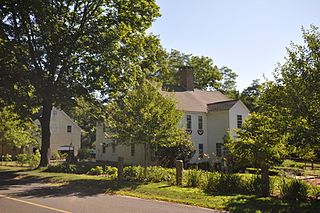
The Old Lyme Historic District encompasses the historic village center of Old Lyme, Connecticut. Located mainly on Lyme Street south of Interstate 95, the village, settled in the mid-17th century, has an architectural history dating to the early 18th century, flourishing as a shipbuilding center and home to many ship captains. It was listed on the National Register of Historic Places in 1971.
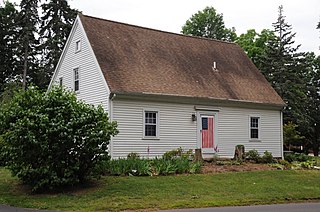
161 Damascus Road is a historic house in Branford, Connecticut. Built about 1750, it is a well-preserved example of mid-18th century colonial residential architecture. It was listed on the National Register of Historic Places in 1988.

The Eliphalet Howd House is a historic house at 675 East Main Street in Branford, Connecticut. Probably built about 1730, it is one of the town's few surviving 18th-century houses, and a good example of a two-story Georgian colonial house. It was listed on the National Register of Historic Places in 1988.

The Rising Sun Tavern is a historic house and former public accommodation on Old Tavern Road in North Haven, Connecticut. Probably built around 1760, it is a well-preserved example of an 18th-century tavern house, serving in that role into the mid-19th century. Now a private residence, it was listed on the National Register of Historic Places in 1979.






















